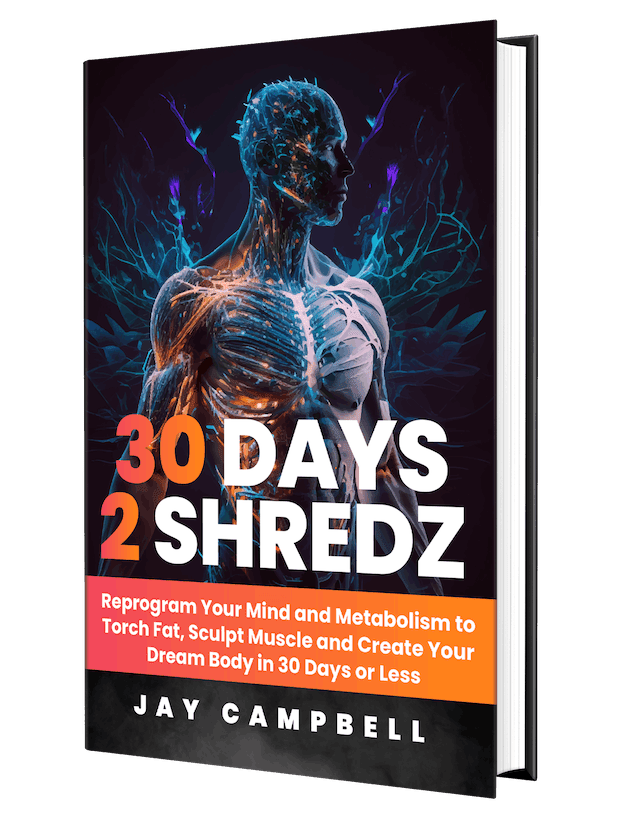If there’s one thing the mainstream media is right about, we live in an age of rampant misinformation and even deliberate disinformation about fat loss.
Where they get it wrong is two-fold: (1) WHO is responsible for creating the misinformation, and (2) the DIRECTION said misinformation goes.
I’ve covered this before in the past when the New York Times was wrong about hair loss.
They get a mulligan because even with the root cause of hair loss fully solved, there are still many complexities and intricacies we don’t know about.
But when it comes to the topics of fasting and fat loss… we still have a lot of work to do.
And I can’t think of a more obvious disinformation merchant than the fitness industry’s favorite doctor: Dr. Peter Attia.

Sure, he has some decent intel about the anti-aging drug Rapamycin.
Yet he’s dead wrong about more important things such as Metformin impairing muscle & strength gains, while promoting the falsehood that Semaglutide and other GLP-1 receptor agonists “causea” significant lean mass loss.
(He also did a very recent podcast with Dr. Andrew Huberman about Metformin, which I AM looking into… stay tuned for more info down the road)
Today, you’re about to see an egregious example of why even doctors are still wildly unaware of the very basics of fasting and fat loss.
And according to my verdict, Dr. Peter Attia is guilty as sin!
Table of Contents
ToggleA VERY Interesting Study About Testosterone, Fat Loss, and Muscle Preservation
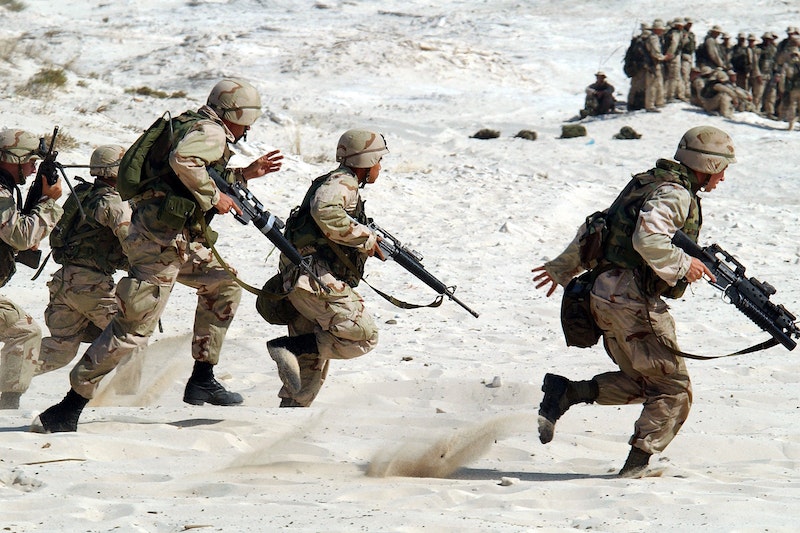
First, let’s provide the context for what I’m talking about.
I came across a two-part article series from Dr. Peter Attia (Part 1, Part 2) published in late August 2019 talking about the preservation of lean body mass during an extended state of “semi-starvation”.
The series revolves around a 2019 paper I wasn’t aware of concerning testosterone’s ability to increase muscle mass and decrease fat tissue DESPITE the presence of an extreme caloric deficit.
For reference, the paper is titled “Effects of testosterone supplementation on body composition and lower-body muscle function during severe exercise- and diet-induced energy deficit: A proof-of-concept, single centre, randomised, double-blind, controlled trial.”
Here is a synopsis of why the research was conducted to begin with:
- Military soldiers undergo extreme conditions during combat operations for extended periods of time (poor sleep, chronic stress, etc.)
- Naturally, one of the main outcomes is a severe energy deficit induced by both high levels of physical activity and insufficient dietary intake
- Everybody under the sun knows this will catabolize both muscle tissue and function, with some studies showing 3-16% initial body mass loss (and 50% of that loss being lean body mass) over as long as 64 days of sustained military training operations.
- Repeat this enough times over one’s career and who knows how detrimental it can be to the long-term health of fit men (given muscle is the single greatest deterrent against the diseases of aging)
- Even measures such as elevating protein intake “appear” to be ineffective in countering the effects of a severe energy deficit
- One fact well-established about severe energy deficits in men is their testosterone-lowering effect, with decreases of 50-65% seen over just one month of US Army Ranger school
This begs the question: What happens when you take non-obese healthy men, subject them to the same energy deficit induced by military operations via diet and exercise, and give them exogenous testosterone?
The researchers hypothesized testosterone would shift the balance to the point where more fat mass is lost and less lean body mass is lost compared to placebo (although the total body mass lost would be equal)… while lower body muscle function would still decline but significantly less compared to placebo.
Let’s see what happened!
The Participants
A total of 50 men were recruited for the study:
- 18-39 years old
- Exercises twice a week via aerobic and/or resistance training
- Must meet age-specific US Army body composition standards
- Total testosterone concentrations were within normal physiological range
- No use of testosterone, testosterone precursors, anabolic steroids, or human growth hormone was permitted within the past 6 months before the start of the study
- No cardiometabolic disorders
- Hematocrit readings above 50% and a prostate-specific antigen (PSA) reading above 3 ug/L
Moving on to the experiment itself…
The Study Design
All 50 participants were subjected to the trial design seen below:
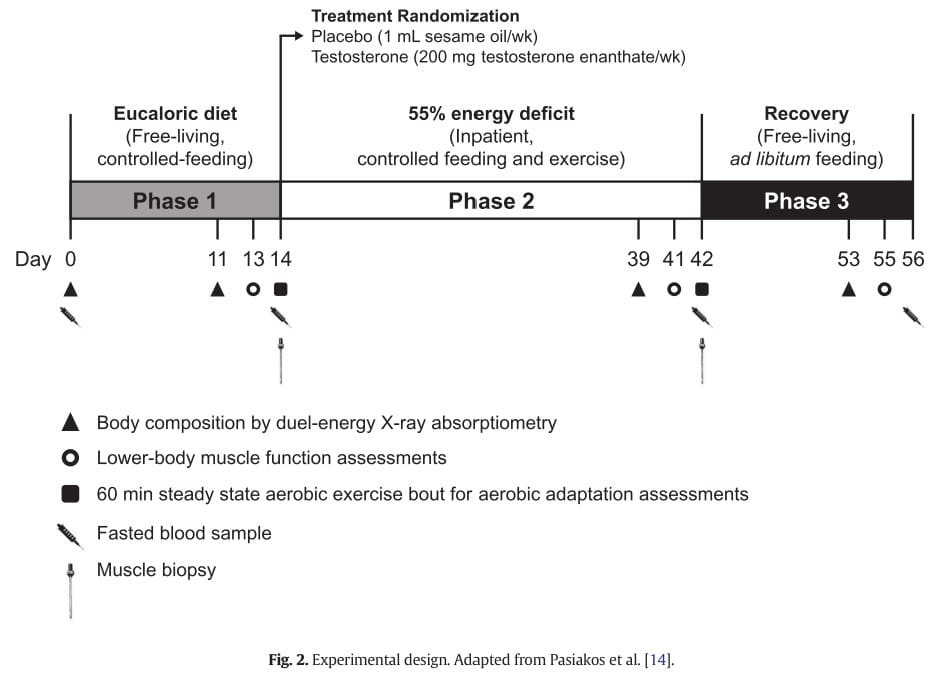
Phase 1 (14 days, Days #0-14)
- After baseline measurements, every subject ate a eucaloric diet (i.e.maintenance) to keep their total body weight within ±2% of their initial measurement
- The diet consisted of the following macronutrients
- 1.6 grams of protein per kilogram of total body weight
- 30% of all calories come from fats
- The remaining calories are attributed to carbohydrates
- Existing physical activity was still maintained
- Notably, dietary intake and caloric burn induced by physical activity was the same across all 50 subjects
Phase 2 (28 days, Days #15-42)
Here is where the fun part begins…
- The men were divided into two separate groups
- Group #1 – 26 men would receive a placebo injection consisting of sesame oil once a week
- Group #2 – 24 men would receive an intramuscular injection of 200 mg of testosterone enanthate once a week
- Both groups engaged in an average of 3.5 supervised exercise sessions per week via steady-state, aerobic-type exercise varying from 40-85% intensity (i.e. peak rate of oxygen uptake)
- Forms of exercise included treadmill walking, outdoor walking, running, elliptical use, stationary bike, or walking while carrying a weighted backpack (30% of body mass)
- This exercise would induce a total caloric burn equivalent to 50% of their maintenance caloric intake
- Both groups also ate a controlled diet equivalent to 45% of the combined calories seen in both the total caloric burn AND their maintenance caloric intake
- Macronutrient ratios were kept the same as seen in Phase 1
- The net result would be a 55% energy deficit every day
- All of the above was done under strict supervision in an inpatient metabolic center
- Notably, there was no induction of sleep restriction or psychological stress in Phase 2
I know this seems awfully confusing, so I’ll simplify the math for you:
- Take an 80 kg male who has a total daily energy expenditure (TDEE) of 2,500 calories from Phase 1 when his diet and activity levels are taken into account
- In Phase 2, he would exercise to the point where his exercise-induced energy expenditure (EIEE) would be 50% of his baseline TDEE, which comes out to 1,250 calories
- So now his final TDEE in Phase 2 would be 2,500 calories + 1,250 calories = 3,750 calories
- We then take 45% of this brand-new TDEE, which comes down to 1,687 calories consumed and a 2,063 calorie deficit
- Next, we follow the macronutrient ratios used in Phase 1
- 1.6 grams of protein per kilogram of total body weight multiplied by a body weight of 80 kg gives us 128 grams of protein (512 calories)
- 30% of 1,687 calories amounts to 506 calories of fats (i.e. 56 grams of fat)
- 1,687 calories – 512 calories – 506 calories = 669 calories of carbohydrates (i.e. 168 grams of carbs)
Phase 3 (14 days, Days #43-56)
- All 50 patients are released from the metabolic center and taken off their weekly injection protocols, whether for placebo or testosterone
- Patients returned to their habitual physical activity and diet patterns (i.e. “free-living”) to assess recovery of total body mass and skeletal muscle mass
- Food records were taken on 3 days in the week prior to Day 56
- A leniency period of up to 42 days maximum was allotted to see if body mass would be recovered within ± 2.5% of a subject’s initial body mass
Measurements (Days #0-56)
- Body composition was measured via dual-energy X-ray absorptiometry (DEXA) on days 0, 11, 39, and 43
- Lean body mass = total body mass – fat mass – bone mineral content
- Body weight was measured every day after an overnight fast and while semi-nude
- Lower-body muscular strength was assessed on days 13, 41, and 55 using isometric and isokinetic knee extension tests
- Blood samples were collected on days 0, 14, 42, and 56 while fasted between 6am-9am to avoid the impact of circadian rhythm on hormone readings
- Biomarkers measured were total testosterone, follicle-stimulating hormone (FSH), estradiol, sex hormone-binding globulin (SHBG), luteinizing hormone (LH), insulin, cortisol, prostate-specific antigen
- Free testosterone was calculated and not directly measured
The Results
What happened was a complete shock to the researchers.
In Phase 2, the placebo group (Group #1) had lower free testosterone, unchanged total testosterone, and increased SHBG.
The testosterone group (Group #2) not only had increased levels of free and total testosterone, but their levels were higher than in the placebo group.
(Although haematocrit and haemoglobin readings were higher compared to placebo, and SHBG was lower than placebo group despite remaining unchanged)
But take a look at the body composition changes throughout the entire study, especially Phase 2:
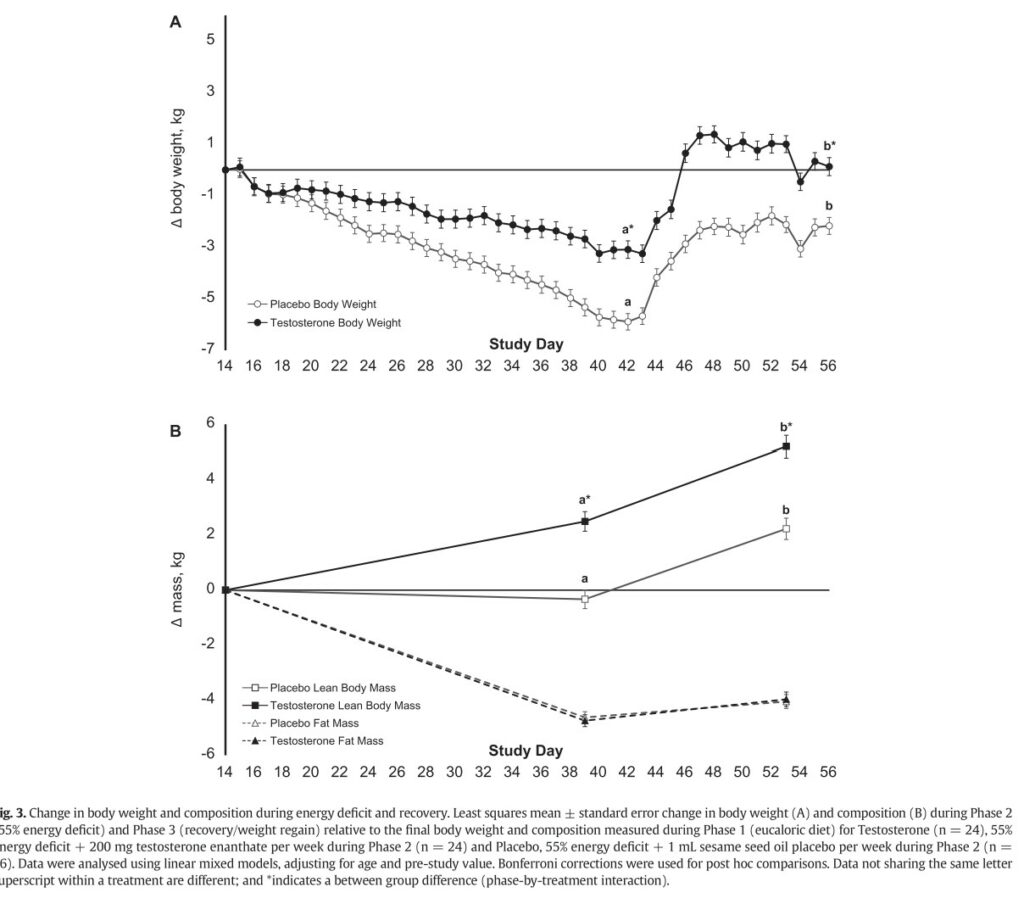
If the graph is confusing, let me break it down for you:
- Both treatment groups experienced similar fat mass loss (10 lbs of fat on average by the end of Phase 2)
- The testosterone group gained roughly 5-6 pounds of lean body mass by the end of Phase 2
- The placebo group MAINTAINED lean body mass (the white square at point “a” in graph B), and in the worst-case scenario we’re talking about less than a POUND of lean body mass loss
- The change in total and free testosterone was associated positively with a change in lean body mass
- Unfortunately, both groups suffered a similar decline in lower-body muscle function
As for Phase 3:
- Despite dietary intake being the same between both groups, both groups regained body weight and lean body mass
- However, the gains in both body weight and lean body mass were greater in the testosterone group compared to the placebo group
- Sadly, measures of muscle function were similarly lower in Phase 3 compared to Phase 1 for both groups
Now that I’ve done my deep-diving into this study, here are the Jay Campbell takeaways…
First, the study is picture-proof of testosterone’s simultaneous anabolic (muscle-building) and lipolytic (fat-burning) capabilities regardless of the dietary setup.
I have written about this extensively in The TOT Bible and have successfully coached tens of thousands of men through the process of optimizing their testosterone levels.
I’m frankly baffled at how the researchers could have even hypothesized the testosterone group would lose ANY muscle mass.
But this is what happens when academia is far separated from real-world practice.
Second, you CANNOT expect optimal physical performance on a severe energy deficit.
Even with testosterone optimization therapy, you still require the fundamentals of nutrition to be fully dialed in.
Any average gym bro knows that during a “cutting” phase (i.e. a caloric deficit), you will not be lifting as you potentially can compared to being in a “bulking” phase (i.e. a caloric surplus).
You fight to preserve as much muscular strength as possible while accepting there MAY be some slight loss in strength as you get deeper into your cut.
Third, protein intake reigns supreme for preserving muscle tissue during a caloric deficit.
The supplementary document provided with this study says it all:
“…physically active adults consuming 1.6 and 2.4 g/kg [per day] during a 21-day, 40% energy deficit lost more body fat, spared more muscle mass, and maintained muscle protein synthetic responses to feeding to a greater extent than those who consumed 0.8 g/kg [per day].
There were also no differences between those consuming 2.4 g/kg [per day] and 1.6 g/kg [per day], suggesting that during moderate, sustained energy deficit, there are no advantages of consuming protein beyond twice the RDA.
These findings, which were derived from a well-controlled clinical trial, were used to develop operationally relevant dietary protein recommendations.
However, consuming approximately 1.6 g/kg [per day] has generally been overwhelmed by the effects of severe energy deficit on protein retention during real-world military operations.”
The last sentence refers to three studies (here, here and here) demonstrating instances where a higher protein intake was not enough to overcome the effects of extreme caloric restriction on muscle tissue atrophy.
However, keep in mind these studies have a combination of flaws:
- “Real-world military operations” include activities such as a 51-54 kilometer ski march for 3-4 days straight and living at higher altitudes of +4 kilometers
- Body composition is not always directly measured, and molecular phenomenons such as “protein turnover” and changes to indicators of “muscle damage” (ex. creatine kinase) are looked at instead
- In the case of the one study looking at higher altitudes, nothing is mentioned about the EXERCISE done while at a 40% energy deficit for 22 days straight (all they did was low-to-moderate intensity treadmill walking, running, and hiking to induce an increase in EIEE that was 10% above their baseline TDEE… no weight lifting whatsoever)
I’m not saying these studies are completely worthless, yet CONTEXT is what gets thrown out of the window when people talk about “science”.
For the overwhelmingly vast majority of humanity, and especially my readers, they will not find themselves in such extreme situations.
Which transitions towards the last point I want to make before ripping Dr. Attia to shreds…
Fourth, pay special attention to the fact there was NO sleep restriction or psychological stress induced.
I would even go as far as to argue the exclusion of these two variables made a significant difference in the end result.
Without writing another article entirely, there is a very clear link between sleep deprivation and muscle loss across multiple studies (such as here and here).
And the medical community at large is just beginning to understand how chronically elevated cortisol levels (i.e. stress) are detrimental to the maintenance of skeletal muscle mass (here and here).
Although I would have loved to see what the outcomes of the study would have been if proper resistance training was thrown in, these kinds of experiments are rarely performed and published.
So it’s good to see my many years of real-world experience and wisdom fully validated.
What Dr. Petter Attia Fails To Understand About the Study, Fat Loss, and Fasting

Now, onto the main part you’ve been waiting for.
When Dr. Attia talked about this paper in Part 1 of his two-part article series, he starts off with this sentence:
“…one of the potential drawbacks of severe caloric restriction (CR), and fasting, as health-promoting tactics are the loss of LBM and muscle function that can accompany them.”
Keep this statement fresh in your mind because you’ll soon see why it is wholly inaccurate.
For the rest of the article, he did a good job of summarizing the most important takeaway points in the study.
He also emphasized how surprising it was for the placebo group to have no losses in lean body mass whatsoever, just as I did.
However, the ending of Part 1 demonstrates a severe lack of understanding as to WHY the scientists got the results they did:
“It’s remarkable to me that these individuals (1) were able to exercise at a high volume, and (2) did not lose any muscle mass during this month.
How is it possible that these participants were able to expend so much energy, eat in a “caloric deficit,” and maintain lean body mass? What would’ve happened if they didn’t eat at all (i.e., water-only fasted)?”
Um… did he not READ the study?
- The higher protein intake of 1.6 g/kg of total body weight with its muscle-sparing effects, as ALREADY demonstrated in the literature?
- The lack of additional contributing factors to muscle tissue decay such as excess cortisol and sleep restriction
- The fact these were already healthy adults with some experience in lifting weights, and not obese metabolically-dysregulated dumpster fires?
- The type of low-intensity steady-state endurance exercise being done in a so-called “semi-starved” state?
We are then directed to Part 2, where there is some truth riddled with an incredible amount of error.
Take this excerpt, for instance:
“Another way to stimulate MPS [muscle protein synthesis] is by exercising (resistance training in particular, but also aerobic exercise, perhaps to a lesser degree). However, this also stimulates MPB [muscle protein breakdown].
If that’s the case, how can we build muscle if exercise both stimulates the synthesis and breakdown of protein? It turns out that exercise also sensitizes skeletal muscle to the anabolic effects of a protein-containing meal, which can result in an overall increase in MPS and LBM.
But if we’re fasting, apparently there’s no protein-containing meal to be had.
Anecdotally, during my week-long water-only fasts where I engage in daily resistance exercise and 1-2 zone-2 rides, I don’t seem to lose any muscle mass. (Granted, I’m basing this off pictures and bioelectrical impedance scales for the most part, so there may be some small margin of error.) Given the apparent constraints above, how is this possible?”
Oh boy, where to begin?
One, as I have already explained in The Metabolic Blowtorch Diet, you CANNOT lift weights in a fasted state.
Your body is not biochemically primed to lift heavy weights since you require full muscle glycogen stores to do so.
Not to mention your amino acid stores, liver glycogen stores, and circulating blood glucose are all depleted.
And the lack of synovial fluid in your joint capsules due to muscle cell dehydration from long fasting windows.
Not only do you set yourself up for suboptimal performance in the form of unnecessary physical exhaustion, you also increase the risk of serious injury.
Two, it’s interesting to note Dr. Attia has since walked back this anecdotal observation.
In a recent Twitter post, he admitted he stopped fasting because he “was losing too much muscle mass.”
Three, and we’ll get into much more detail on this soon, a week-long fast with only water is definitely far too long for the preservation of muscle tissue.
We’re recently finding out how water fasts of 5-20 days can lead to a ton of weight loss, sure, but “approximately two-thirds of the weight lost is lean mass, and one-third is fat mass”.
(Although shorter fasts of 36-48 hours are very beneficial for fat mobilization… again, timing and context are critical here)
Continuing on… Dr. Attia then talks about the importance of ketone production during fasting, which he correctly says will “spare the body’s protein from oxidation” (and by extension prevent skeletal muscle breakdown).
And he even goes into the nuances of protein breakdown within the body during a fast:
“During fasting, insulin and glucose plummet while counter-regulatory hormones increase (e.g., growth hormone, adrenaline), setting up a milieu that favors fat-oxidation and enhanced autophagy.
While protein breakdown exceeds protein synthesis during a week-long fast, this does not necessarily mean that MPB exceeds MPS.
All cells contain proteins, so when proteins are catabolized, this may be preferentially coming from skin and intestinal cells, for example, compared to muscle cells.
It stands to reason that during times of famine, muscle preservation is favored over other cells that turnover more rapidly.”
(He also gives a shout-out to Dr. Jason Fung, who has done a lot of great work in explaining the mechanisms behind muscle maintenance during extended fasts)
But then he goes back into error in the next paragraph:
“Globally, mTOR—described as the cell’s general contractor by my friend David Sabatini—is turned down during fasting. But, the mechanical stress from resistance training can turn up mTOR (mTORC1, to be more specific) locally (i.e., in muscle cells), independent of growth factors and amino acids (which are the two other well-known ways to turn up this protein complex).
This may help partition some of the amino acids in the body that are broken down toward muscle, thus preserving muscle mass. I don’t think it’s out of the realm of possibility that you can “eat” a meal of protein that contains all of the essential amino acids during a fast.
This may be one of the benefits of autophagy, which literally translates to ‘self-eating.’ Your muscle cells may be dining off your skin cells, so to speak.”
You can definitely eat the meal he’s talking about… that is, if you want to BREAK YOUR FAST!
Once you consume anything with calories in it – BCAAs, preworkouts with calories, “essential” aminos, MCT oil, milk/cream added to black coffee – the fast is over and you have to start all over again from Hour Zero.
I certainly hope he isn’t suggesting you can eat this meal and still be in a fasted state.
The last paragraph lowers my faith even further in Dr. Attia’s ability to understand exactly how fasting and fat loss work in the human body:
“Obviously, the longer you fast, the more you drain your internal sources of food, and the more likely MPB will exceed MPS over time. (This may also suggest that the fatter you are to begin with, the longer you can eat yourself, and presumably maintain muscle mass for longer.)
If you want to ADD muscle mass to your frame, fasting is obviously not the best strategy. Getting leucine, and all of the essential amino acids for that matter, from outside sources is a must for long-term growth and maintenance of muscle mass.
But in the short-term (at least up to a week for most people), I believe you can maintain muscle mass while fasting, particularly if you’re resistance training.”
There is some truth to the idea of fat-as-f*ck dumpster fires being able to handle longer fasts because it will take even longer for their body fat stores to be fully exhausted before lean muscle tissue is ever tapped into.
Yes, fasting is not a viable strategy for ADDING pounds of muscle to your physique.
And Dr. Attia is right in saying you can absolutely maintain muscle mass (despite his recent statements self-contradicting what he is writing here).
But no, you absolutely should not be resistance training during a fast for the reasons I have already mentioned.
Overall, there may be some decent points in Dr. Attia’s two-part article series, but so much of it is riddled with falsehoods and a fundamental misunderstanding of human biology.
As much as I am harping on him here, it scares me to even think about what other less-educated doctors believe about the life-changing benefits of fasting beyond accelerated fat loss.
The Myth of “Fasting-Induced” Muscle Loss Has to END!
Before I wrap up, I want to share this interesting excerpt from an interview Dr. Petter Attia recently did with Russell Brand.
When I heard you’re about to see below (skip to 26:10 in the video), I fell out of my chair:
“I used to fast a lot, Russell. So I used to do 7-10 days of water-only fasting once a quarter, and 3 days once a month. So I was very aggressive in my use of fasting.
And I have no way of knowing if all the years of doing that added, you know, years to my life, subtracted years to my life, we have no way of knowing this because we don’t even have a biomarker for all those processes I spoke about.
Now what I can tell you is that after many years of doing that fasting, I lost a staggering amount of muscle mass. Probably to the tune of 20 pounds over a decade.
And for me, now I’m going to fast forward to the year 2020, I took one more look at a DEXA scan, which is a body scan that shows you how much muscle you have, and I realized that actually, something like over 6 years I’ve lost 20 pounds of muscle, I was like “I think I’ve got to cut back on this fasting thing” because one of the drawbacks of so much fasting is you just can’t maintain lean mass.
But I had no idea what the dose should be, and to this day I don’t know what the dose should be, which again ties into this frustration that says “Boy I wish we could study that problem” because if you take the amount of money that it takes to approve one drug, I believe we could answer all of these questions with respect to how much to exercise, what kind of exercise, how much to fast, for how long. It truly is a distorted set of priorities.”
So it turns out you can’t fast without saying good-bye to your hard-earned gains.
And nobody in the medical field knows what the precise method and duration of fasting should be in order to maximize fat loss and minimize muscle loss.
I wouldn’t blame you for believing this if your go-to’s for legitimate health information are Dr. Petter Attia and other quacks like Dr. Andrew Huberman.
But now you’re here reading and listening to me.
Therefore, I AM telling you there is no longer an excuse to believe in these myths!
As a matter of fact, it’s because of people like Dr. Attia that I have to put out warnings in my private inner circles like the one below:
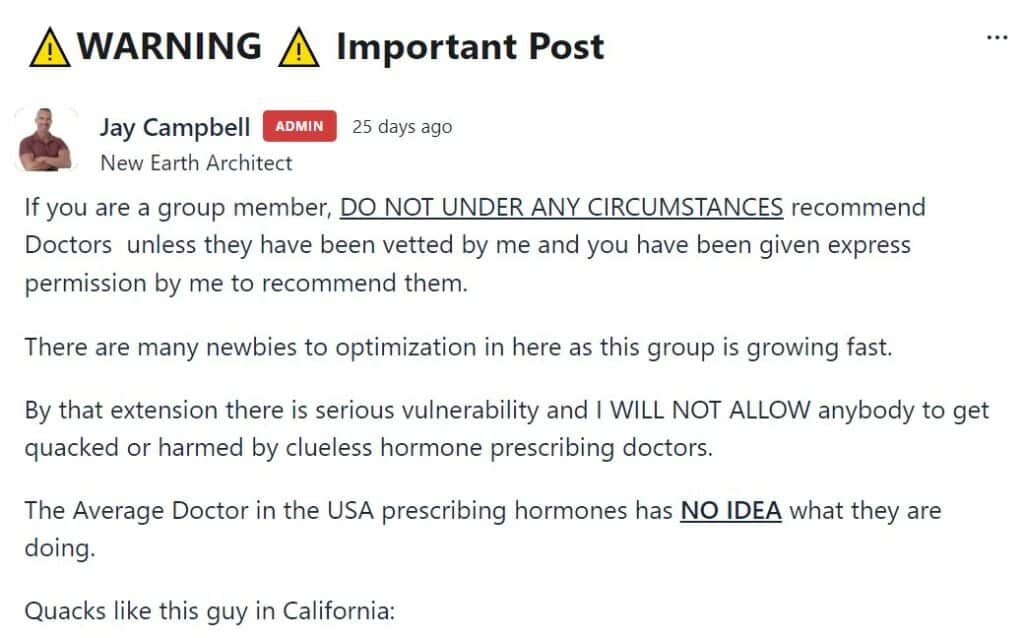

It has to be done.
Disinfo merchants are NOT allowed in my community due to the irreparable harm they will cause to my readers and clients.
30 Days 2 Shredz: The Definitive, Long-Awaited Book for Fasting and Fat Loss Done Right

If you aren’t subscribed to my email list, following me on social media, or a paying member in my private Fully Optimized Health community, you wouldn’t know I’ve already solved Dr. Attia’s problem ages ago.
The above video was published and released in 2018 for free… take a second to think about this when you hear Dr. Attia say “we don’t know” about what works best for fasting.
Not just by creating the greatest book ever on how to fast for fully optimized health without any muscle tissue loss whatsoever…
But the greatest FAT LOSS book of all time to help men and women lose the most amount of body fat possible in 30 days without destroying their health.
It’s called 30 Days 2 Shredz and after an entire year of tireless work and unforeseen publishing delays, I AM proud to finally put it in your hands.
(Here are the links for those of you who live in Canada, EU/UK, or Australia)
It covers every single falsehood made by Dr. Attia in his article series and elsewhere:
- The RIGHT duration of fasting for rapid fat loss (and when to cap it off so you don’t start catabolizing muscle tissue)
- The RIGHT exercises to do while fasted (and what you absolutely must avoid)
- How to CORRECTLY use GLP-1 receptor agonists like Semaglutide, Tirzepatide, and Retatrutide without eating away at a single gram of muscle mass
- The RIGHT way to fast (and all the ways to avoid breaking it)
- WHEN to lift weights so you can take advantage of the anabolic benefits provided by resistance training
- WHAT to eat (and when) to preserve muscle tissue
- The ESSENTIAL lifestyle habits for supporting your body’s fat-burning processes and shutting off its muscle-wasting properties
You’ll also discover…
- Novel breakthroughs in the science of human metabolism forcing us to rethink what is understood about high-speed fat loss
- Biomedical tech gadgets, select peptides, medical technologies, and other underground tools designed to shred more stubborn body fat per unit of time
- Training protocols designed for all levels of conditioning to accelerate the fat loss process even further
- Exhaustive case studies of people who made life-changing transformations from all walks of life – young or old, lifelong athlete or lifelong dumpster fire
- Brutally difficult diet hacks for the Type-A personality who wants to break the limits of what is realistically possible for achieving total leanness
If you read the book for yourself and believe I have made good on my word, I will ask for an honest and positive Amazon review in exchange.
(NOTE: Here are instructions for reading books on Kindle if you have never done so)
When you do, please send proof of your Amazon purchase and review (once it is LIVE) to [email protected].
In exchange for this small favor, you’ll have access to the EPIC bonuses below:
🔥 Anybody who purchases an Amazon-certified copy and leaves us a genuine review will get FREE access to the 30D2S Private Vide Masterclass.
This will be filmed LIVE (in many episodes) by Hunter Williams and myself.
Episode 1 has already come and gone on September 12th, but there is still time to RSVP for Episode 2 before it is launched on Tuesday September 19th at 7pm EST.
Mark it on your calendar — the only other time you’ll be able to see these episodes is in the form of a paid $499 video course.
🔥 The FIRST 250 people to leave a 5-star review on Amazon will be entered into a raffle.
5 tickets (retail price of $999 – $1,499) are being given away for the Fully Optimized Health LIVE event in Tampa, Florida on October 20-22nd, 2023.
Even if you don’t get the bonuses above or want them, the least you can do is get the book and shave YEARS off your physique development curve.
In the words of my good friend Hunter Williams, whose jaw-dropping before-and-after pictures you’ll find in Chapter 10 of the book:
“The 30 Days 2 Shredz fat loss protocol is the undisputed GOAT of any fat loss program ever given to mankind. No other fat loss program in human history comes even close.”
As always…
Raise Your Vibration To Optimize Your Love Creation!
PS – To guarantee your very first time using 30 Days 2 Shredz is an absolute success, join The Fully Optimized Health Private Membership Group.
It’s your greatest opportunity to fully optimize your health and gain total access to me and my network of high-level men and women living their highest and best lives.


